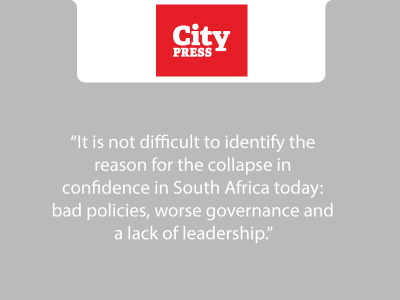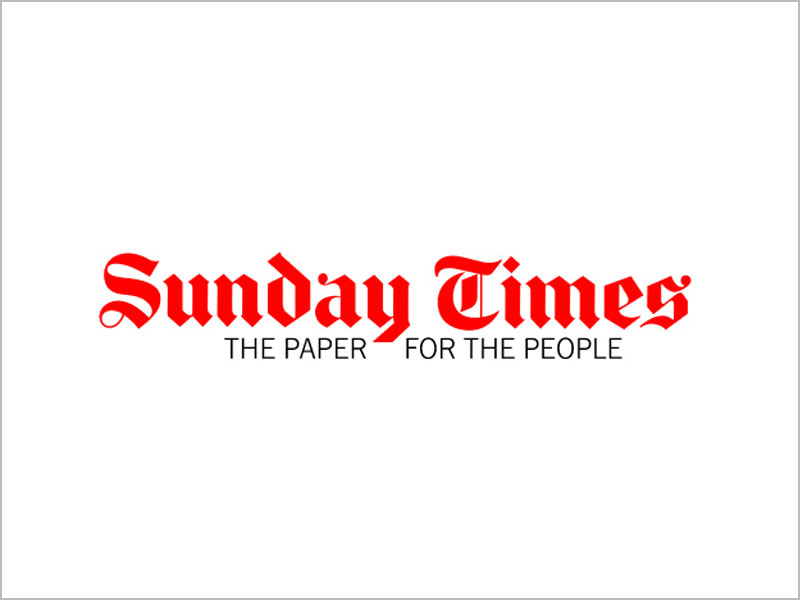Restoring confidence in South Africa is the key to growth

Two weeks ago, Minister in the Presidency, Khumbudzo Ntshavheni, said we should all draw inspiration from the fact that the economy had grown at an annualised rate of 0.4%. Even assuming we could sustain that – the International Monetary Fund thinks growth this year will be 0% – at 0.4% an economy doubles in size every 180 years. It was roughly the rate of growth during the 1 000 years between the fall of Rome and the industrial revolution.
The main reason that growth is so slow in South Africa is that confidence in the future has collapsed. The conviction that the future will be better than the present is what drives investment in human and physical capital. In its absence, people and businesses avoid the risk of investing. The brighter and more prosperous the future is expected to be, the greater the amount of investment. Conversely, the bleaker the future looks, the less people will invest.
It is not difficult to identify the reason for the collapse in confidence in South Africa today: bad policies, worse governance and a lack of leadership.
To understand this dynamic, it is helpful to think about the choices that a farmer faces when contemplating an investment in, say, an irrigation system or a dam or in buying a neighbouring property to expand production. The critical thing for this thought exercise is that the cost of the contemplated investment is large in comparison with the farmer’s income.
So this is not a trivial decision; the famer is risking significant losses if his investment fails to pay off.
In contemplating the investment, our hypothetical farmer must consider what will determine the chances of success and the amount of money he will make if it does succeed. Some of these factors are under his control or can be known with a high degree of certainty. But this is not true of many other issues.
The farmer knows the quality of the soil. He also knows how hard he is prepared to work, how many people he will have to employ and what he will have to pay them. He knows something about how much it will cost to build the dam or irrigation system and buy whatever equipment he might need.
There may be some uncertainties: construction costs, for example, are generally not known with 100% certainty at the start of a project.
The farmer, then, might have a pretty good idea of how much his investment will cost. He also may know about how much extra produce his investment will generate.
Again, there may be some uncertainties, for example, variations in annual rainfall. Still, these are all the variables that the farmer knows with reasonable certainty and, apart from the weather, he has at least some control over most of them.
Now let us think about all the factors that affect the long-term value of his investment but over which he has no control:
- The price of crops will vary with the value of the rand, as will that of inputs such as seed, fuel and fertiliser. He can hedge against adverse movements, but the costs of insurance rise with risk.
- The availability and cost of electricity may depend on Eskom and the decisions of any number of ministers and regulatory bodies that have some responsibility for its generation and distribution.
- The quality, reliability and cost of the logistics involved in moving his product from farm to market, especially if that involves exports through the ports, may depend on Transnet and on the decisions of the transport minister, which may be impossible to anticipate.
- The rate of taxation he will pay on his income and profits depends on the decisions made by the minister of finance, as he decides how much government will spend and whom it will tax.
- The interest rate he will pay on any debt he has accumulated will depend on the level of public debt, which is the key driver of long-term interest rates.
- Whether he will recoup his investment might depend on if and how the land expropriation without compensation policies are implemented or on whether his land will be invaded – something the authorities may not assist with.
- If he needs a water licence, he may worry that he will not get one, whether through bureaucratic ineptitude or policy change.
- He has no real control over how much of his product might be stolen or whether his suppliers or customers will try to cheat him and, if they do, whether the courts will ensure that he is compensated.
Every one of these uncertainties has a material bearing on his investment decision, since each impacts on the quantity of the produce he might harvest, the costs he incurs, the price which he will get for his produce and the amount of profit he will make.
These uncertainties are underpinned by another issue: if he gets his calculations wrong and the investment goes pear-shaped, will he be able to sell his farm? And, if he does, will he get a price that is high enough to ensure that the loss on the investment will be sufficiently small, so as to provide a measure of insurance against the worst-case scenario?
It is hard to overstate the importance of this last, largely unconsidered, factor in deciding on potential investments.
Commercial activity is largely underpinned by the degree of confidence that entrepreneurs, including farmers, have in the existence of a market for their assets if they ever have to walk away from them.
The vibrancy of this market makes it possible to take bets on the future in the knowledge that the downside-risk is limited because one can sell one’s assets at a reasonably robust price.
If the secondary market for businesses and business assets is weak, that fact alone magnifies all the risks that are inherent in all commercial activity.
And, as even a moment’s reflection will confirm, these markets are driven by sentiment, so that, if future expectations darken, prices in the secondary market for businesses will fall.
And, as those prices fall, businesses will become more wary of making new investments for fear that they will not be able to recoup a sufficiently large portion of their costs if they are unable to turn a profit.
This, ultimately, is the key fact about the kinds of commercial investment needed to drive growth: it is sensitive to expectations about the future – costs and revenues in the future. If government is serious about economic growth, it needs to restore confidence in the future by removing all the impediments and uncertainties that inhibit investment.
One thing is very clear, until there are far greater levels of confidence in South Africa’s future, investment rates will not rise.
And the only way to get investment in the future is visionary leadership prepared to make the hard choices required. This will mean establishing a team in government characterised by a common commitment to prioritising growth, jobs and building an effective state where people are held accountable for publicly announced delivery targets and timetables.
Bernstein is head of the Centre for Development and Enterprise. This article is based on the CDE’s new report, titled SA’s anti-growth strategy: How poor policy and bad governance are wrecking growth
Article published by the City Press







